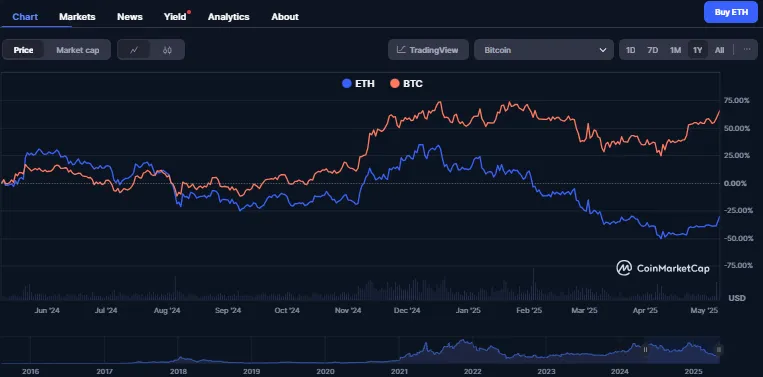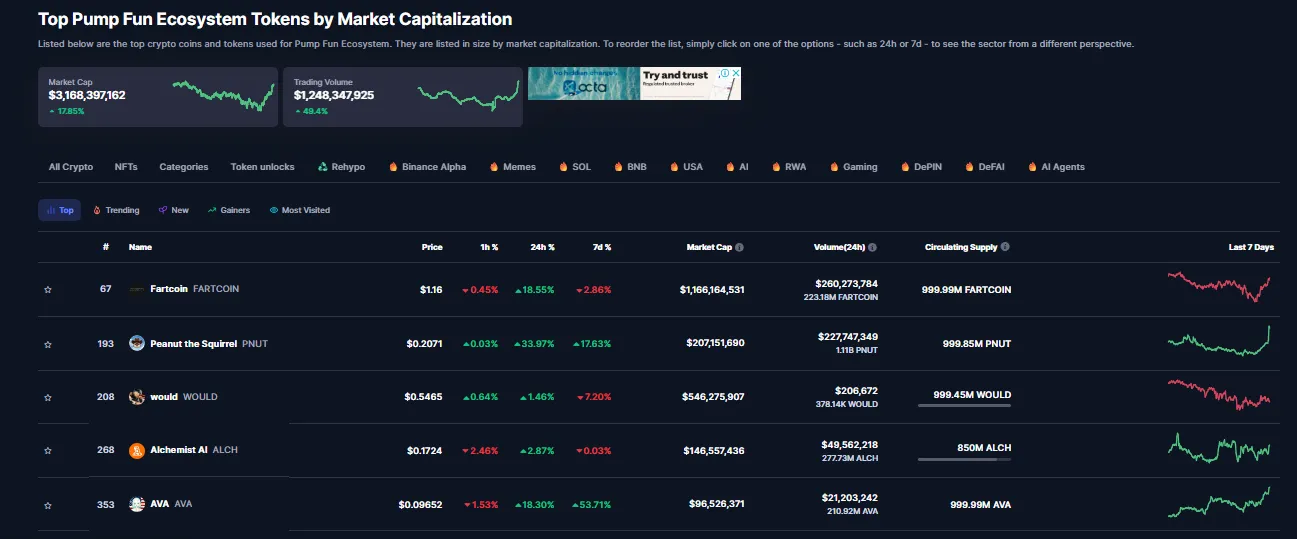By Isaac Olatunji
Compiled by: Vernacular Blockchain
Unless you’re a person who lives in crypto, there’s hardly anyone who hasn’t noticed Ethereum’s decline over the past few months. Price action, market dominance, community sentiment — you name it, they’re all at all-time lows! The top cryptocurrency seems to be falling sharply — not even setting a new all-time high this cycle. However, over the past few days, Ethereum seems to be rebounding. Why has it been underperforming for months? Can the current momentum drive it back to health?
Ethereum’s Dilemma
Ethereum is struggling, there is no doubt about it. Since December 2024, whenever the market sentiment shifted and caused the overall crypto market to fall, only Bitcoin was able to rebound to its previous price and break through, while Ethereum fell and could hardly get back to the starting point.
Here is a look at Ethereum's market performance in recent months. In November 2024, the market was in an uptrend, with Bitcoin at around $96,405 and Ethereum at $3,703. On December 1, 2024, the market saw a slight decline, with Bitcoin falling to $93,557 and Ethereum falling to $3,337. Although both top cryptocurrencies reached important price levels later that month, they failed to maintain their gains and fell again.
About a month later, on January 1, 2025, Bitcoin is trading at $94,500, slightly higher than the month before, while Ethereum has fallen further to $3,298. By February 1, price data shows Bitcoin has fallen sharply to $84,381 and Ethereum has fallen to $2,236. Bitcoin reached $102,000 later that month, but Ethereum failed to rebound to its previous highs. In fact, while Bitcoin recovered from $84,381 in February to $94,304 in April, Ethereum continued to fall and was unable to retest its previous highs. In fact, the BTC/ETH ratio has widened, as shown in the chart data.

Source: CoinMarketCap
At press time, Ethereum is trading around $2,400, which is a decent gain considering its performance in recent months. However, it has yet to hit higher price ranges. What exactly is wrong with the Ethereum market? Let’s analyze a few key points.
Bitcoin and meme coins steal the show
Bitcoin and Meme Coins have been stealing the show in recent months. You may have heard about the news that the US government is planning to set up a Bitcoin reserve. This plan is widely discussed among retail and institutional investors, and many US state governments are also moving forward with establishing strategic Bitcoin reserves. Texas and New Hampshire have made progress in this regard, as have other US states and some other countries.
The interest of sovereign states has further attracted the attention of market whales and institutional investors. Recently, Michael Saylor announced that Strategy (formerly MicroStrategy) has purchased additional Bitcoin to consolidate its position as the public company with the largest Bitcoin holdings. Out of the total supply of 21 million Bitcoins, Strategy holds more than 555,000 Bitcoins.
While Bitcoin took center stage and overshadowed Ethereum, memecoins were doing the same. Unfortunately, these memecoins were not launched on the Ethereum chain. One of the most successful memecoins of 2025, Fartcoin, with a market cap of over $1 billion, was launched on the Solana chain. The popular memecoin issuance platform PumpFun is also on Solana. You may not have noticed, but most of the hottest memeTokens created in late 2024 and 2025 came from PumpFun.

Source: CoinMarketCap
Therefore, Ethereum has clearly missed out on the hype. In addition, the discussion around decentralized finance (DeFi) has also decreased significantly, as no major innovations have emerged. Overall, Ethereum has not been at the center of any major hype - nothing has driven its price up.
Liquidity flows to sub-networks
Ethereum’s high gas fees have been a major impediment to its growth. To make matters worse, the Ethereum network is flooded with Layer-2 networks such as Polygon, Optimism, Base, Linea, Arbitrum, etc. These Layer-2 networks compete with Ethereum for liquidity. With the existence of USDC, these networks do not require much ETH to complete operations. Not to mention that a variety of activities can be carried out on these Layer-2 platforms, so fewer transactions pass through the Ethereum main chain. Therefore, if the on-chain usage is high, the demand for ETH should have risen, but it is not the case now.
Competitive Network
We’ve already touched a little on how competitors like Solana are chipping away at Ethereum’s market dominance. The fact is, Solana offers a better experience for developers and users. Who wouldn’t want a faster, cheaper, and more powerful chain? According to Coingecko’s report on Solana, the continued activity on the Solana chain sheds light on why it continues to attract more developers and retail investors. Here are some of the reasons that stand out:
Higher performance and scalability: Solana can process up to 3,000 transactions per second, and can theoretically even reach 65,000 TPS. Regardless, Ethereum's processing capacity of 15 transactions per second is simply no match. Considering Solana's extremely low cost when processing large transactions, it is obvious why developers prefer it. Active and helpful ecosystem: The Solana ecosystem provides developers with rich resources and tools, which promotes its growth. The Solana ecosystem provides developer toolkits and funding opportunities, allowing new projects to emerge seamlessly. Similar to Solana, Avalanche is also growing in popularity and capabilities. Institutional adoption of these Layer-1 platforms will further weaken Ethereum's dominance. Hyperliquid and Tron have made progress in perpetual futures trading and stablecoin markets, respectively.
Limited institutional interest
While global companies, market giants and countries continue to accumulate Bitcoin, the situation of Ethereum is completely different. According to Coingecko data, there are very few public companies holding Ethereum, with a total value of less than $500 million, while the figure for Bitcoin is more than $50 billion.
The crypto ETF market shows a huge gap between the demand for Bitcoin and Ethereum, with the latter failing to record high inflows like the former. ETF inflow data shows that Bitcoin has attracted a large number of large investors with its first-mover advantage and widely accepted value storage function. Although Ethereum has recorded billions of dollars in funds in spot ETFs, its figures are still far behind Bitcoin.
Ethereum’s Hope: Will It Make a Comeback?
Ethereum needs an awakening to regain market dominance, attract widespread investment, and soar in value. At the time of writing, Ethereum has just activated an upgrade. This is a welcome development, but it does not solve the challenges of bridging assets and data in the Ethereum Layer-2 ecosystem. Competitors such as Solana still have an advantage because users can switch seamlessly between multiple decentralized applications (DApps). Nevertheless, the upgrade seems to have had a positive impact on the price of Ethereum, which has risen 20% in the past 24 hours to $2,400. Will this top alternative token make a comeback this time? We must wait and see how much improvement the recent upgrade can bring to the Ethereum chain and whether this is enough to get ETH back on track.





